Source code in github. See below.
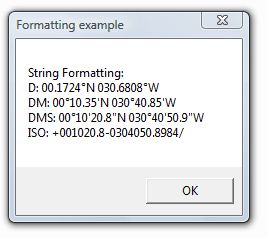
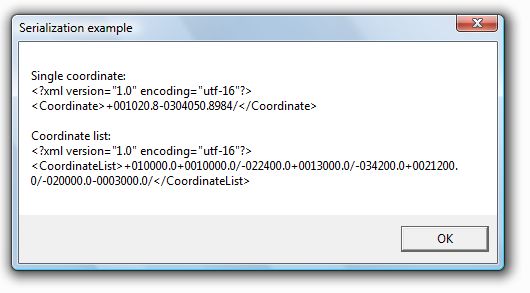
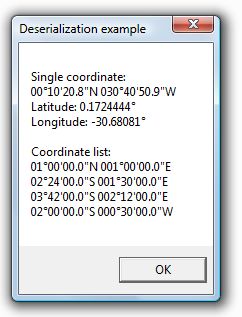
Introduction
I have seen many articles here at CodeProject about coordinates and GPS signal handling, like "Writing your own GPS Applications" and "Distance between locations using latitude and longitude" among others. Most of them do some tasks around a latitude/longitude pair, but they don't handle coordinate storage with care. This article provides a solution to manage coordinates at both memory and persistent storage (XML or database), complying with the ISO 6709 standard (Annex H - Text string representation), in concordance with the World Wide Web Consortium's LatitudeLongitudeAltitude workgroup.
Background
Previous readings:
- ISO 6709 - "Standard representation of geographic point location by coordinates" - at Wikipedia.org
- LatitudeLongitudeAltitude workgroup - at World Wide Web Consortium (W3C)
- ISO 31-1 - "Quantities and Units - Space and time" - at Wikipedia.org
In-memory storage
A geodesic coordinate has two main components: latitude (a.k.a. "y") and longitude (a.k.a. "x"). Both latitude and longitude are expressed in sexagesimal degrees and decimals, according to ISO standards, with the following constraints:
- Positive values for North and East hemispheres
- Negative values for South and West hemispheres
- Latitude values from -90.0 to +90.0
- Longitude values from -180 to +180.0
With these constraints, we can conclude that coordinates could be stored in a pair of 32-bit single precision data type, known as float in C# and C++ [see the addendum "Why to use float?" at the end of this article]. But, there are more decisions pending... latitude and longitude are usually expressed in degrees, minutes, and seconds. A minute is 1/60 of a degree, and a second is 1/3600. So, if we store a latitude or longitude in degrees unit, we will have to convert from 1/60 and 1/3600 fractions, to entire values, and back again to degrees and decimal; this will cause a cumulative loss of precision.
After many years working with coordinates, I concluded the best unit to store coordinates is not degrees but "seconds of degree". This way, all coordinate elements (degrees, minutes, and seconds) will remain on the integral portion of values, with the exception of decimal of seconds, avoiding the annoying loss of precision. The first approach to implement a coordinate class would be then:
class Coordinate
{
float latitude;
float longitude;
}
Here is an example on how to store a coordinate as explained above:
- Latitude: 05º 13' 01.3" S
- Longitude: 080º 37' 49.5" W
- In degrees and decimals: { -(5 + 13/60 + 1/3600), -(80 + 37/60 + 49/3600) } equals { -5.2169..., -80.6303... }
- Optimized storage: { -(5*3600 + 13*60 + 1.3), -(80*3600 + 37*60 + 49.5) } equals { -18781.3, -290269.5 }
XML serialization
The .NET Framework provides facilities to easily store and retrieve data in XML format; if you associate an XML serializer object with the above class, you will have a result like:
<Coordinate>
<Latitude>-18781.3</Latitude>
<Longitude>-290269.5</Longitude>
</Coordinate>
This is barely 90 - 100 bytes per coordinate, including spacing characters. Just figure out a 100,000 node geographic file. This will require nearly 10 MB of file storage! Here is where ISO comes to the rescue. If you have read the ISO 6709 explanation, you will know a proper representation for our sample data would be, among others:
- -05.2169-080.6303/ expressed in pure degrees, or
- -051301.3-0803749.5/ expressed in degrees, minutes, and seconds
So, if we override the default serializer for our Coordinate class to use the second version, we can expect a result like:
<Coordinate>-051301.3-0803749.5/</Coordinate>
At first glance, you will notice a storage saving of more than 50%. Also notice that, besides the fact that our class stores data in-memory conveniently in "seconds of degree", XML storage is expressed in degrees, minutes, and seconds, so you can interpret the XML file by yourself, without conversion formulas. Now, you have the best of both worlds.
Coordinate class implementation
The first part of the Coordinate class implementation has the following fields and properties declarations:
[Serializable()]
public class Coordinate : ICloneable, IXmlSerializable, IFormattable
{
#region Private fields
private float latitude;
private float longitude;
#endregion
#region Constructors
public Coordinate()
{
Latitude = Longitude = 0.0f;
}
public Coordinate(float lat, float lon)
{
Latitude = lat;
Longitude = lon;
}
#endregion
#region Properties
public float Latitude
{
set
{
latitude = value * 3600.0f;
}
get
{
return latitude / 3600.0f; }
}
public float Longitude
{
set
{
longitude = value * 3600.0f;
}
get
{
return longitude / 3600.0f; }
}
#endregion
You can see how latitude and longitude fields have been hidden from external usage and serialization. There are a couple of properties instead, Latitude and Longitude (with lead uppercase character); they can be accessed by the user, and return values as degrees and decimals, hiding our underlying storage format (seconds of degrees). Also, two constructors have been implemented: a default constructor, which sets lat/lon as zeroes, and a custom constructor which receive lat/lon as degrees and decimal with proper sign.
Following with code, you will find the public methods, to either set and get values in a friendly way:
#region Public methods
public void SetD(float latDeg, float lonDeg) {...}
public void SetDM(float latDeg, float latMin, bool north, float lonDeg, float lonMin,
bool east) {...}
public void SetDMS(float latDeg, float latMin, float latSec, bool north, float lonDeg,
float lonMin, float lonSec, bool east) {...}
public void GetD(out float latDeg, out float lonDeg) {...}
public void GetDM(out float latDeg, out float latMin, out bool north, out float lonDeg,
out float lonMin, out bool east) {...}
public void GetDMS(out float latDeg, out float latMin, out float latSec, out bool north,
out float lonDeg, out float lonMin, out float lonSec, out bool east) {...}
public float Distance(Coordinate other) {...}
public void ParseIsoString(string isoStr) {...}
#endregion
The first version of the setter, SetD, just needs two arguments expressed in degrees and decimal with proper sign for the hemisphere. It is equivalent to setting the Latitude and Longitude properties independently. The following two overrides will need minutes and hemisphere explicitly, and seconds optionally. In this case, the degrees arguments should not contain the hemisphere sign. The getter has a one-by one correspondence with the setters.
Finally, you will find a method to calculate the distance against other coordinate. It is implemented using the classical Haversine formula (you will find web references inside the code). The result is expressed in meters, the ISO unit for distances. You can add your own code for more calculations.
The following methods in the code implement some fundamental overrides:
#region Overrides
public override string ToString() {...}
public override bool Equals(object obj) {...}
public override int GetHashCode() {...}
#endregion
The default implementation of Coordinate.ToString() will return a string with the coordinate expressed in degrees, minutes, and seconds. There will be more implementations of this method. Equals() compares both the latitude and longitude values for equality, and GetHashCode() returns a hash value based on the lat/lon values. The following code implements the IFormattable interface, allowing to display coordinates in different fashions:
#region IFormattable Members
public string ToString(string format) {...}
public string ToString(string format, IFormatProvider formatProvider) {...}
#endregion
As the IFormattable.ToString() method accepts a second argument that is unused in this implementation (formatProvider), an abbreviated override has been added with just an argument: the format string. Valid format strings are the following, with a little example:
- "D": 05.2169ºS 080.6303ºW
- "DM": 05º13.02'S 080º37.82'W
- "DMS": 05º13'01.3"S 080º37'49.5"W (default)
- "ISO": -051301.3-0803749.5/
Any other formatting string will produce an exception. Calling any version with an empty or null formatting string will output the default version. But, we still have not seen the best feature of the IFormattable interface; we can embed the formatting string inside a more complex formatting case; for example:
string s = string.Format("Our sample coordinate is: {0:DM}\r\n.", someCoord);
Finally, there is the IXmlSerializable implementation. It overrides the default XML formatting, as explained earlier. Here is the abbreviated source code:
#region IXmlSerializable Members
System.Xml.Schema.XmlSchema IXmlSerializable.GetSchema() {...}
void IXmlSerializable.ReadXml(XmlReader reader) {...}
void IXmlSerializable.WriteXml(XmlWriter writer) {...}
#endregion
You don't have to invoke these functions directly, they will be invoked by any serialization function, as you can find in the test source code below. WriteXml() will produce XML code for storing the latitude and longitude in ISO format with the pattern: "±DDMMSS.S±DDDMMSS.S/". ReadXml(), countersense, will parse a coordinate stored with any valid ISO format, even those including the height or depth, not considered for this implementation. An incorrect format will produce an exception.
Coordinate collections
Once using the Coordinate class, you will notice another source of space wasting. Consider the following example:
<CoordinateList>
<Coordinate>+010000.0+0010000.0/</Coordinate>
<Coordinate>-022400.0+0013000.0/</Coordinate>
<Coordinate>-034200.0+0021200.0/</Coordinate>
<Coordinate>-020000.0-0003000.0/</Coordinate>
</CoordinateList>
A real-world GIS application will need hundreds of <Coordinate> entries for each polygon. So, the ISO standard comes again to the rescue by storing the data in a more compact fashion:
<CoordinateList>+010000.0+0010000.0/-022400.0+0013000.0/
-034200.0+0021200.0/-020000.0-0003000.0/</CoordinateList>
Again, we have a storage saving of more than 50%. Implementing the CoordinateList class is quiet easy. You just need to derive a generic List<Coordinate> collection and override the serialization methods from the IXmlSerializable interface. Here is the template:
[Serializable()]
public class CoordinateList : List<Coordinate>, IXmlSerializable
{
#region Constructors
public CoordinateList() {...}
#endregion
#region Overrides
public override string ToString() {...}
#endregion
#region Public methods
public void ParseIsoString(string isoStr) {...}
#endregion
#region System.Xml.Schema.IXmlSerializable Members
XmlSchema IXmlSerializable.GetSchema() {...}
void IXmlSerializable.ReadXml(XmlReader reader) {...}
void IXmlSerializable.WriteXml(XmlWriter writer) {...}
#endregion
}
Database storage/retrieving
A single coordinate or a coordinate collection can be stored in any text field type into a database. For storage, you have to prepare the query string using the proper ToString() method, as in the following example:
string query =
string.Format("INSERT INTO PointMarks SET ID={0}, LOCATION='{1:ISO}'",
someID, coord);
string query =
string.Format("INSERT INTO Boundaries SET ID={0}, POLYGON='{1}'",
someID, coord_list);
Notice that when inserting a single coordinate, the "ISO" formatting should be used, since the Coordinate.ToString() method has many formatting options, as explained earlier.
To retrieve a single coordinate or coordinate collection, just create a new object and invoke the ParseIsoString() method, passing the string retrieved from the database, like in the following example. A try/catch block also will be recommendable, to avoid an unexpected exception.
string iso = datareader["LOCATION"].ToString();
Coordinate coord = new Coordinate();
coord.ParseIsoString(iso);
string iso = datareader["POLYGON"].ToString();
CoordinateList coord_list = new CoordinateList();
coord_list.ParseIsoString(iso);
The sample code
The supplied sample code in the Program.Main() method will do some little tasks to demonstrate the Coordinate and CoordinateList classes functionality. The solution file included with this article has been produced with Visual Studio 2008, so you won't be able to load directly from Visual Studio 2005, but you can create a new solution and attach the project file manually.
static void Main()
{
Coordinate c = new Coordinate();
c.SetDMS(00, 10, 20.8f, true, 30, 40, 50.9f, false);
CoordinateList cl = new CoordinateList();
cl.Add(new Coordinate( 1.0f, 1.0f));
cl.Add(new Coordinate(-2.4f, 1.5f));
cl.Add(new Coordinate(-3.7f, 2.2f));
cl.Add(new Coordinate(-2.0f, -.5f));
MessageBox.Show(
string.Format("String Formatting:\r\nD: {0:D}\r\nDM: {0:DM}\r\nDMS:" +
" {0:DMS}\r\nISO: {0:ISO}", c),
"Formatting example");
System.Text.StringBuilder sb = new System.Text.StringBuilder();
System.IO.StringWriter sw = new System.IO.StringWriter(sb);
string part1, part2;
System.Xml.Serialization.XmlSerializer xs =
new System.Xml.Serialization.XmlSerializer(typeof(Coordinate));
xs.Serialize(sw, c);
sw.Flush();
part1 = sb.ToString();
sb.Length = 0;
System.Xml.Serialization.XmlSerializer xsl =
new System.Xml.Serialization.XmlSerializer(typeof(CoordinateList));
xsl.Serialize(sw, cl);
sw.Flush();
part2 = sb.ToString();
sw.Close();
MessageBox.Show(string.Format("Single coordinate:\r\n{0}\r\n\r\n" +
"Coordinate list:\r\n{1}", part1, part2),
"Serialization example");
System.IO.StringReader sr = new System.IO.StringReader(part1);
Coordinate c1 = (Coordinate)xs.Deserialize(sr);
sr.Close();
sr = new System.IO.StringReader(part2);
CoordinateList cl1 = (CoordinateList)xsl.Deserialize(sr);
sr.Close();
string message = string.Format(
"Single coordinate:\r\n{0}\r\nLatitude: {1}°\r\nLongitude:" +
" {2}°\r\n\r\nCoordinate list:\r\n",
c1, c1.Latitude, c1.Longitude);
foreach (Coordinate coord in cl1)
message += coord.ToString() + "\r\n";
MessageBox.Show(message, "Deserialization example");
}
Addendum: Why use float?
I have received many questions about why I use the float data type, instead of the Int32, double, or decimal data types. Here are some reasons about the use of float against Int32 (expressed in milliseconds of degree or other scales):
- There is no meaningful advantage in storing size with an
Int32, since float is 32-bits too.
- When you have to calculate coordinates components (D/M/S), you will need to convert to floating point anyway.
- When painting, it has to be converted to floating point.
- Also, float conversion will be needed to store in ISO 6709 format.
- If expressed in milliseconds, the code will be less legible due to continuous multiplication/division by 1000.
About float against decimal, which is four times larger than float, the main disadvantage, besides the obvious space consumption, is performance. Calculations with decimal are 20-30 times slower than with float. This is due to the fact that decimal is stored as base-10 by microprocessor, not as base-2 like all other data types, forcing it to do several converdions to perform any math calculation.
About float against double, there are concerns about precision that deserves a bigger explanation. First, I will mention the advantages:
- The
double data type (64 bits) needs twice the space as float (32 bits).
- Half the space and half the time to load in memory.
- Precision is enough compared to GPS precision (5-10 meters).
About precision, you have to be aware of the internals of the float data type, as explained in Wikipedia (http://en.wikipedia.org/wiki/IEEE_754). It reserves 8 bits for the exponent and 23 bits for the mantissa. This means that a float value can contain 223 different values, besides the exponent. Now, let's go to the most pessimistic calculation:
A longitude with a maximum value of 180 degrees at the Equator that has 60 nautical miles per minute, when stored in a float variable, will have a precision of:
180 * 60 * 1,852 meters / 223 values = 20,001,600 / 8,388,608 = about 2.4 meters
But, the longitude magnitude will vary according to the latitude, with the equation decreasing up to zero at the poles. The precision will increase when the latitude is greater, according to the following chart:
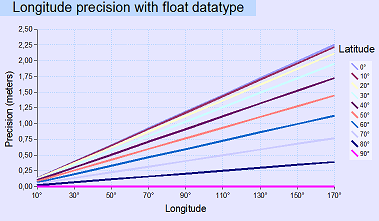
The case of latitude is different. It doesn't vary in any zone of the earth, with a constant magnitude of 60 nautical miles per minute of degree, and a maximum value of 90 in the poles. The most pessimistic calculation for the latitude (near to the poles) will be:
90 * 60 * 1,852 meters / 223 values = 10,000,800 / 8,388,608 = about 1.2 meters
The following chart depicts the precision of latitude stored in a float variable, according to the latitude value:
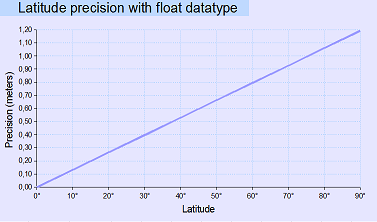
So, we can conclude that in practical terms, we will have an average precision value fewer than a meter. This is far more precise than a GPS output, and suitable for most GIS applications up to street level.
Class enhancements
There are a lot of things you can do to enhance this fundamental class, I will include some of the following in the next version:
- Altitude/depth element
- NMEA sentences parsing
- UTM system translation
- More geodesic calculations
Source Code
The source code of Coordinate.cs and a Winforms demo application can be found now in github: https://github.com/jaime-olivares/coordinate
History
- Apr 29th, 2007
- Jun 10th, 2007
- Fixed bug in
ToString() method (thanks to Travis Butcher).
- Oct 23rd, 2007
- Fixed bug in the
string.Format() example.
- Nov 07th, 2007
- Finally added the
CoordinateList class.
- Nov 28th, 2007
- Added database examples.
- Fixed globalization bug (thanks to Antoine Polatouche).
- Nov 30th, 2007
- Added explanation about
float values.
- June 08th, 2009
- Added explanation about decimal data type.
- September 16th, 2015
- Moved the source code to
github.
